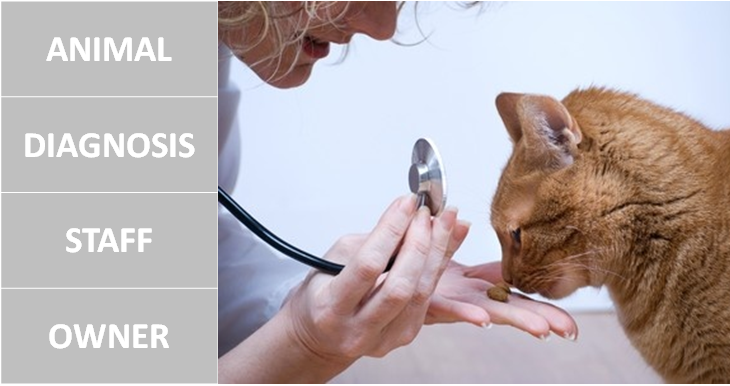This post is part of a series on addressing animals’ fear in the veterinary clinic.
Why feed treats? The technical term is counterconditioning (CC), and it’s about feeding fabulous treats in order to reduce fear.

This post is part of a series on addressing animals’ fear in the veterinary clinic.
Why feed treats? The technical term is counterconditioning (CC), and it’s about feeding fabulous treats in order to reduce fear.

In previous posts, I have described systematic desensitization (SD – introducing scary things gradually), and counterconditioning (CC), learning to associate potentially aversive stimuli with something nice.
The combination procedure is called SD/CC, DS/CC or CC/D depending on who you’re talking to; some people skip the first word of SD and only talk about desensitization. The procedure looks the same, though: after each exposure to the stimulus, the animal gets something it really likes.
The basic SD/CC to teach a cat to accept an injection may look like this – note that there may be up to 20 intermediate steps between each of these (for instance, when introducing the needle):
But remember, do not move on to the next step until you see that the animal is completely comfortable and at ease at the current step (the relaxation part of SD) and is looking for the tuna (showing signs of learning the association: CC).
In short, this type of procedure is typically not done in one single session but over several training sessions.
Revised August 2019.
Depending on who you ask, you get a vastly different answer to the question of whether it’s a good idea to pet a frightened dog (or other animal with whom you have an established relationship and that enjoys your touch) during noisy (scary) events.
In the scientific literature, the overwhelming majority of articles (if not all…?) recommend not petting, meaning that petting fearful dogs inadvertently reinforces the anxious behaviour.
Still, in the dog training community, many professional dog trainers do recommend petting an anxious animal, and it has been argued that “petting doesn’t reinforce fear, it reduces it”.

So which is it? Could both sides have a point?
Wanna join this experiment on the effect of tone of voice on dog behaviour? Please share what you found with us in the survey!
Systematic desensitization is an essential part of your toolbox to reduce and eliminate fear.
I know, ten syllables. And yet, it’s one of the most important tools in animal training, so… let me explain it, and perhaps it will be easier to digest.
Let’s call it SD for short.
If you’ve read my other posts in this series, you know I’ve been promoting counterconditioning (or re-learning) as one of the best techniques to reduce fear in the veterinary clinic.
You might be thinking: “Aaaaw, that’s too much of a hassle, there’s no time. Why not just grab the animal, do what needs to be done, and with time, the animal will get used to it? It will habituate.”
There are four reasons why I don’t think that’s a good idea: